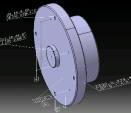
iSquare promises to provide best services at highly competitive costs. Our services range from Consulting, Training Dimensional Control Procedure Implementation, Process review and suggestions. DCS, USA is committed to support iSquare or work jointly for large and demanding services in Dimensional Management.
Consulting:-Dimensional Variation Modeling:-
Creating base line tolerance model based on customer’s tolerancing schemes and assembly processes. We review the input and perform statistical and root cause (HLM) analysis to bring the part issues upfront before investing into expensive tooling, fixtures and gages
Dimensional Requirements Management :-
The "roll-down" of final product interfaces’ Dimensional Technical Specifications used in establishing major system and sub-assembly requirements and evaluating concept alternatives for meeting quality objectives for fit, finish and functionality.
Variation Simulations:-
Three-dimensional tolerance analysis aids in developing robust designs that minimize dimensional variation. When used for defining and managing products’ functional tolerancing and coordinating their measurement data, 3D tolerance analysis significantly reduces the rework required for engineering drawings, tools and gages.
Current production troubleshooting:-
identifying specific contributors, either from the product or the process, and rank critical components tolerances contribution & impact on the total cumulative variation, enhancing product quality while lowering costs.
Current Production Troubleshooting View Image
 3D CAD Data Translation / Repairing:-
3D CAD Data Translation / Repairing:-
Our suite of translation and repair tools developed by TranscenData allows designers, analysts and engineers to exchange their CAD/CAM/CAE data quickly and easily, eliminating up to 90 percent of data rework. Our translation and healing solutions offer numerous advantages and support:
- Multiple CAD imports
- Batch processing
- Intelligent model repair and healing
- Automatic processing Wizards
- User-controlled model Defeaturing
- Interactive fixing tools
- Multiple CAD/CAE exports
We designed the unique 5 stage wizard within our translation and healing solutions to accommodate novice, occasional and experienced users, so translations and repairs requiring manual intervention can be completed with minimal effort:
- Diagnostic results are explained and illustrated in clear, accessible language
- Problems are color-coded according to severity
- Users are guided through a choice of solutions
- Model diagnostics are automatically updated after each repair
The key benefit of our 3D translation and healing solutions, centers on processes which guides users effortlessly through the import, repair and export process, requiring minimal, manual intervention.

Many of our users like to keep it simple - model translation is as straightforward as choosing the file and a target system and letting our solution do the rest.
However, with the vast array of automatic and interactive processing tools available, we enable the user to address almost every issue affecting CAD geometry, effective translation and downstream reuse, such as:
- Stitching models
- Creating missing geometry
- Building solids
- Setting tolerance deviations/requirements across different systems
- Identifying and correcting serious surface definition problems
- Reducing the complexity of geometry for downstream applications
Deliver Quality Translations throughout the Entire Process

- It is not just about translating and fixing. Clients can tailor our solutions to check product data quality (PDQ) using a comprehensive library of PDQ tests.
- Users can also specify the PDQ tests for assessment and set the controlling parameters and tolerances as needed. The completed test then guides the user through a list of potential resolutions to address the quality issues.
- This type of quality analysis automatically identifies entities in the model that fail to meet the requirements of the selected PDQ criteria and presents the results to the user both graphically and in a text report.
- Our quality analysis components also offer customization for in-house policies and/or international PDQ standards such as SASIG, VDA and JAMA.




 Consulting
Consulting
